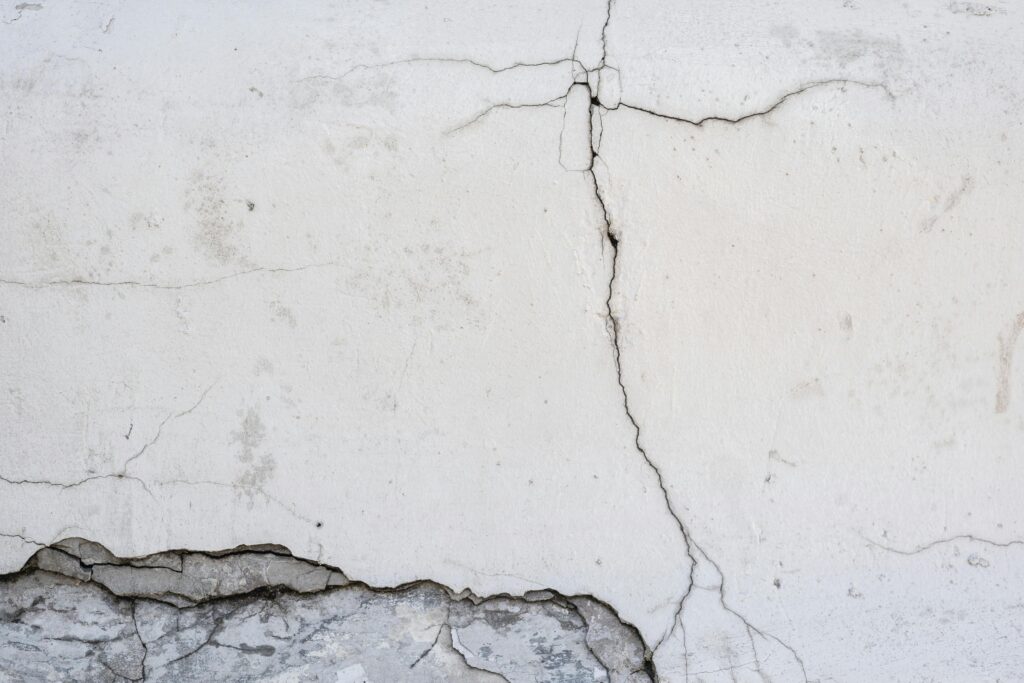Wall cracks are a common occurrence in homes, but they can also be a sign of underlying structural problems. While many cracks are cosmetic, others may indicate more serious problems that require attention.
Types of Wall Cracks
- Hairline Cracks: These are thin, fine cracks that often appear in new construction or due to settling. While they’re usually not a cause for concern, they can be unsightly.
- Horizontal Cracks: Horizontal cracks can be a sign of foundation issues, such as settlement or shifting. These can be more serious, as they often indicate a problem with the building’s structure.
- Vertical Cracks: Vertical cracks can also indicate structural problems. Especially if they are wide or extend through multiple layers of the wall. They might be a sign of foundation movement or other structural issues.
- Diagonal Cracks: Diagonal cracks can be a symptom of foundation problems or structural stress. They often appear in corners or at the base of walls.
Causes of Wall Cracks
- Foundation Settlement: Over time, foundations can settle due to various factors. Including soil conditions, moisture, and the weight of the building. This can cause cracks in walls.
- Moisture: Excessive moisture can weaken walls and lead to cracks. Leaks, humidity, or poor drainage can cause this.
- Poor Construction: Using low-quality materials or inadequate support structures can cause wall cracks. Improper construction techniques also contribute.
- Tree Roots: Tree roots can exert pressure on foundations, leading to cracks in walls.
- Soil Erosion: Soil erosion can undermine foundations, causing them to shift and crack.
- Earthquake Activity: In areas prone to earthquakes, seismic activity can cause cracks in walls.
Identifying Structural Problems
- Widening Cracks: If cracks are getting larger over time, it’s a sign of a potential structural problem.
- Cracks Accompanied by Other Symptoms: Look for signs like sagging floors, sloping walls, or doors that won’t close properly. These can be indicators of more serious structural issues.
- Cracks in Load-Bearing Walls: If cracks appear in load-bearing walls, it’s crucial to address them promptly to prevent structural collapse.
How to Fix Cracks in Walls
- Hairline Cracks: For hairline cracks in plaster, a high-quality filler can be used to repair the damage.
- Larger Cracks: Larger cracks may require more extensive repairs. Such as patching or replacing the damaged section of the wall.
- Structural Issues: If wall cracks are a sign of underlying structural problems, professional assistance is necessary.
Best Filler for Hairline Cracks in Plaster
A good filler for hairline cracks in plaster is a lightweight, paintable spackle. Look for a spackle specifically designed for interior use.

Cracks in New Plaster
Cracks in new plaster are often due to settling or drying. These cracks can usually be repaired with a spackle.
Corner Cracks in Walls
Corner cracks in walls can be caused by settling or foundation movement. Small cracks can be repaired with spackle. For large cracks or issues like sloping floors or stuck doors, consult a professional.
Wall Cracks Prevention and Remediation
- Regular Inspections: Conduct regular inspections of your home to identify potential problems early on.
- Proper Drainage: Ensure proper drainage around your home to prevent moisture damage.
- Tree Care: Maintain trees near your home to minimize root damage.
- Foundation Repair: If you have identified foundation issues, consult a professional for repairs.
- Moisture Control: Address any sources of moisture in your home to prevent further damage.
If you notice significant wall cracks or structural issues, consult a structural engineer. A professional evaluation and recommendations are essential.
When to Call a Professional
If you notice any of the following signs, it’s a good idea to consult a structural engineer:
- Large, widening cracks
- Cracks that extend through multiple layers of the wall
- Cracks accompanied by other structural problems, such as sagging floors or sloping walls
Contact Us Today for a Free Consultation
Our experienced engineers can provide expert advice, conduct thorough inspections, and offer tailored solutions to address your structural issues. Don’t wait for the problem to worsen.
Phone number 01323 409851

